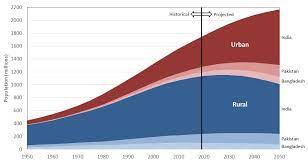
Ground water crisis in South Asia
Ground water crisis in South Asia
Important for Prelims:
United Nations, Sustainable Development Goals, Water Conference, Jal Kranti Abhiyan, National Water Mission, National Rural Drinking Water Programme, NITI Aayog Comprehensive Water Management Index, Jal Jeevan Mission, Jal Shakti Abhiyan, Atal Ground Water Scheme.
Important for Mains:
Global water scarcity and steps taken, water resources, conservation of resources.
November 16, 2023
Context:
According to the United Nations, South Asia is currently the most affected globally in terms of groundwater crisis.
Ground water crisis in South Asia:
Factors responsible for water shortage:
- UNICEF reports that the following factors are responsible for water scarcity in South Asia: poor water quality, inadequate water supply, over-pumping of aquifers and climate change.
- The United Nations has considered climate change as one of the main reasons behind the deepening groundwater crisis in South Asia.
- Climate change reduces the replenishment of water sources, further exacerbating the problem.
- Climate change is disrupting weather patterns and rainfall, leading to increasing water scarcity in countries in the Middle East, North Africa and South Asia.
Impact on communities:
- According to the United Nations, this groundwater depletion has had the greatest impact on children living in South Asia compared to the rest of the world.
- South Asia, a region of eight countries, is currently home to more than a quarter of the world's children.
- Geographically, South Asia includes the countries of Afghanistan, Bangladesh, Bhutan, India, Nepal, Maldives, Pakistan and Sri Lanka.
- By 2022, 739 million children were affected by high or extremely high water scarcity, of which 436 million were from low- and middle-income countries.
- 347 million children under 18 in South Asia face high or extremely high water scarcity, more than any other region in the world.
- According to UNICEF report, extreme water vulnerability is one of the leading causes of death from chronic diseases in children under 5 years of age.
- According to the UN report, due to climate change, more than 35 million children will be vulnerable to water scarcity by 2050 and their mental and physical health will be affected.
- The increasing unpredictability of climate change is likely to worsen the situation for children in South Asia.
Efforts for expansion of water services:
UNICEF is running several programs to expand water services in South Asia:
- UN goals include achieving access to safe and affordable drinking water for all by 2030.
- UNICEF Handbook for Sustainability and Water Quality in Water Services, 2008.
- Arsenic Primer: Guidance on Investigation and Mitigation of Arsenic Contamination.
- UNICEF Strategy for Climate Change and Children's Access to Water and Sanitation 2016-2030
- UNICEF's Water Game Plan (Water Game Plan)
- The Water Game Plan has been developed incorporating key principles of UNICEF's Global WASH Strategy 2016-2030 and the SDG Agenda.
- Realizing the human rights to water and sanitation.
- At the upcoming COP28 summit, UNICEF is calling on the international community to take important steps to protect children, including:
- Incorporating children and inter-generational equity into the Global Stocktake (GST).
- Inclusion of children and climate-friendly essential services in the final decision on the Global Goals for Adaptation (GGA).
Water Conference,2023
- The first water conference was organized by the United Nations from March 22-24, 2023 in New York with the aim of achieving Sustainable Development Goal No. 6.
- The theme of this conference is “Our watershed moment: uniting the world for water”.
Government of India schemes for water conservation
National Water Policy:
- The first policy was formulated in 1987, the second policy was formulated in 2002 and the third policy was formulated in 2012.
Prime Minister Agricultural Irrigation Scheme:
- Pradhan Mantri Krishi Sinchai Yojana (PMKSY) was launched in 2015-16 with the objective of increasing physical access to water on farmland and expanding the cultivable area under assured irrigation. Apart from this, the scheme was also launched with the objective of improving agricultural water use efficiency, implementing sustainable water conservation practices.
Jal Shakti Abhiyan, ‘Catch the Rain’ campaign:
- Under this campaign by the Ministry of Jal Shakti, “Rain water harvesting systems have been created across the country, both in rural and urban areas, to conserve rain water.
Atal Ground Water Scheme:
- The objective of this scheme is to improve the management of groundwater resources in selected water stressed areas of the identified states like Gujarat, Haryana, Karnataka, Madhya Pradesh, Maharashtra, Rajasthan and Uttar Pradesh.
- Clean India Mission
- Jal Jeevan Mission
- water revolution campaign
- National Water Mission
- National Rural Drinking Water Program
- NITI Aayog Composite Water Management Index
- Jal Shakti Abhiyan
About UNICEF:
- The United Nations Children's Fund (UNICEF) was established by the United Nations General Assembly on December 11, 1946.
- In the initial phase it was called United Nations International Children's Emergency Fund.
- Polish physician Ludwik Roschman played a major role in the formation of UNICEF.
- The main objective of this organization was to provide food and health care in emergency situations to children and mothers in countries devastated by World War II.
- In 1953, it became a permanent part of the United Nations and the words 'International' and 'Emergency' were removed from the name of this organization.
- UNICEF is funded by governments and private organizations.
Conclusion:
- In circumstances of water scarcity, external investment should be encouraged to increase access to safe drinking water and sanitation services to protect children from the impacts of climate change.
-------------------------------------------
Mains Exam Question
“Safe water is a basic human right.” In this context, discuss appropriate measures to solve the groundwater crisis.